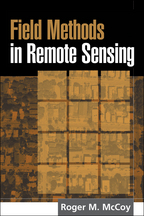Field Methods in Remote Sensing
Roger M. McCoy
Paperbacke-bookprint + e-book
Paperback
orderNovember 11, 2004
ISBN 9781593850791
Price: $38.00159 Pages
Size: 6" x 9"
This concise, much-needed guide takes readers step by step through planning and executing field work associated with many different types of remote sensing projects. Remote sensing texts and research reports typically focus on data-analytic techniques while offering a dearth of information on procedures followed in the field. In contrast, this book provides clear recommendations for defining field work objectives, devising a valid sampling plan, finding locations using GPS, and selecting and using effective measurement techniques for field reflectance spectra and for studies of vegetation, soils, water, and urban areas. Appendices feature sample field note forms, an extensive bibliography on advanced and specialized methods, and online metadata sources.
“A 'must read' for anyone who applies remote-sensing techniques, especially for students who study remote sensing as a discipline and for professionals who need to conduct fieldwork on remote sensing projects. Researchers heading into the field for the first time will find the book an extremely useful primer of practices and procedures. Readers will find its clear explanations of theories, intuitively understandable illustrations for complex issues, practical procedures for guiding field data collection, and wealth of information in the appendices—including a bibliography, field forms, and online links—very beneficial. McCoy's book is well organized. It offers a concise and systematic review of field methods for remote-sensing applications....Instructors may...find McCoy's book a necessary supplementary reading in their courses.....Deserves a prominent place on a student's reading list....A book that makes remote-sensing systems and the field methods appropriate to their validation accessible to all. This book will help even the informed reader to better construct a systematic and comprehensive understanding of remote sensing.”
—Geographical Review
“A very useful text for those who are new to the process of field data collection in remote sensing....provides a good first step overview.”
—Cartographic Perspectives
“Concise, easy to read....The author's experience with field methods, which comes from years of teaching remote sensing and physical geography and conduction research in remote sensing of vegetation, soils, and hydrocarbons, enables him to present much practical advice to the reader....The book is a valuable guide to field measurement methods for students and professionals.”
—Photogrammetric Engineering and Remote Sensing
“Until now, there have been few and limited attempts to address the critical issue of field methods in remote sensing. This text is a welcome and needed addition to the field. It speaks to this gap in the literature of both remote sensing pedagogy and research methodology. Students and professionals alike should find its guidelines, bibliography, and sample field note forms most useful. I intend to use the text in my courses in advanced remote sensing and digital image analysis, for upper-level undergraduates and graduate students, respectively.”
—Floyd M. Henderson, Department of Geography, University at Albany, The State University of New York
“It is strange that no comprehensive publication on this important subject has appeared until now. Professionals and students will be indebted to McCoy for his explanations in plain English of the ins and outs of conducting field work for remote sensing projects, based on his years of practical experience. The book covers all areas of remote sensing where field work is required, ranging from biophysical to social applications. There are detailed discussions on the use of GPS, methods of sampling, and field spectroscopy, and the appendices are also particularly useful. Full of sound advice, this is an indispensable contribution for all those engaged in remote sensing. It will also serve as a text in undergraduate- and graduate-level field methods courses. I strongly recommend this book.”
—C. P. Lo, Department of Geography, University of Georgia
“This book fills a void that exists in other remote sensing texts. McCoy shows the reader how to collect ground reference information in support of remotely sensed data and offers helpful sample problems and solutions from his many years of experience in the field. I highly recommend this text as a complement to the standard remote sensing books for all graduate students who will be collecting ground reference (ground truth) data. In addition, professionals who use GPS, GIS, or remote sensing data will find this text to be a handy guide in improving the value of their field measurement and observations. This book should be a part of the library of anyone who uses remote sensing data.”
—Chris J. Johannsen, Department of Agronomy (Emeritus), Purdue University
Table of Contents
1. Problems and Objectives in Remote Sensing Field Work2. Sampling in the Field
3. Finding Locations in the Field
4. Field Spectroscopy
5. Collecting Thematic Data in the Field
6. Measurement of Vegetation
7. Soil and Other Surface Materials
8. Water Bodies and Snow Cover
9. Applying Concepts of Field Work to Urban Projects
Appendix 1. Selected Bibliography on Field Methods and Related Topics Not Cited in the References
Appendix 2. Field Note Forms
Appendix 3. Metadata Online Resources
